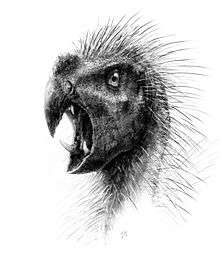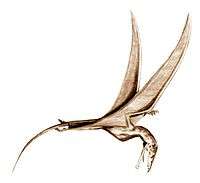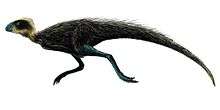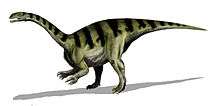Pegomastax
| Pegomastax Temporal range: Early Jurassic, 200–190 Ma | |
|---|---|
 | |
| Lower jaws of specimen SAM-PK-K10488 | |
| Scientific classification | |
| Kingdom: | Animalia |
| Phylum: | Chordata |
| Class: | Reptilia |
| Clade: | Dinosauria |
| Order: | †Ornithischia |
| Family: | †Heterodontosauridae |
| Subfamily: | †Heterodontosaurinae |
| Genus: | †Pegomastax Sereno, 2012 |
| Type species | |
| †Pegomastax africana[1][2] Sereno, 2012 | |
Pegomastax ("strong jaw") is a genus of heterodontosaurid dinosaur discovered in Lower Jurassic rocks in South Africa. It is based on SAM-PK-K10488, a partial skull including a postorbital bone, both dentaries (the tooth-bearing bone of the lower jaw), and a predentary (a toothless beak-like bone found at the tip of the lower jaw).[1] From head to tail the parrot-like herbivore measured no more than 60 cm.


This specimen was found in Voyizane, Joe Gqabi District, Cape Province, in rocks of the upper Elliot Formation, a rock formation that dates to the early part of the Early Jurassic (Hettangian–Sinemurian, approximately 200 to 190 million years ago). It was collected during a 1966–1967 expedition but not formally named and described until 2012, when Paul Sereno, who had recognized it as unusual in the 1980s, published a description. The type species is P. africana.[2] Pegomastax differed from other heterodontosaurids by details of the skull. The lower jaw was robust, with a short beak. Like most other heterodontosaurids, Pegomastax had an enlarged canine-like tooth at the beginning of the lower jaw's tooth row, which may have had a defensive function.[1]
References
- 1 2 3 Sereno, Paul C. (2012). "Taxonomy, morphology, masticatory function and phylogeny of heterodontosaurid dinosaurs". ZooKeys. 226: 1–225. doi:10.3897/zookeys.226.2840. PMC 3491919
 . PMID 23166462. Lay summary – The New York Times (October 3, 2012).
. PMID 23166462. Lay summary – The New York Times (October 3, 2012). - 1 2 While originally introduced as Pegomastax africanus, the species name has since been corrected to Pegomastax africana in order to comply with regulations of the International Code of Zoological Nomenclature, since the Greek word μάσταξ (mastax) is of feminine gender.Sereno, P. (2012). "Corrigenda: Sereno PC (2012) Taxonomy, morphology, masticatory function and phylogeny of heterodontosaurid dinosaurs. ZooKeys 226: 1–225". ZooKeys. 227 (227): 101. doi:10.3897/zookeys.227.4091. PMC 3487651
 . PMID 23166466.
. PMID 23166466.



